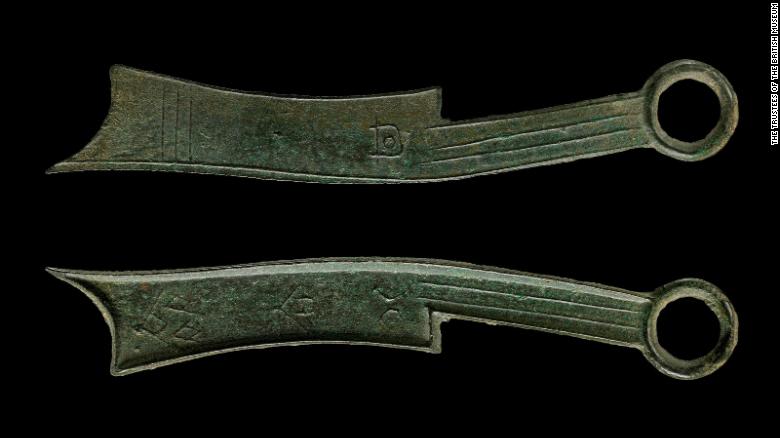دبي، الإمارات العربية المتحدة (CNN) -- ساعد تحليل لنصوص وعملات معدنية تعود لـ2300 عام باحثين على فك رموز الوصفات القديمة لتصنيع معدن البرونز.
وكُتبت أقدم موسوعة تقنية معروفة، واسمها "Kao Gong Ji"، حوالي عام 300 قبل الميلاد، وهي جزء من نص أكبر يُسمى "Rites of Zhou"، أي طقوس تشو.
ويتضمّن النص القديم ست صيغ كيميائية لخلطة البرونز، ويأتي على ذكر عناصر مثل السيوف، والأجراس، والفؤوس، والسكاكين، والمرايا، وكذلك كيفية ُصنعها.
وعلى مدى الـ100 عام الماضية، جهد الباحثون لترجمة اثنين من المكونات الرئيسية لصناعة البرونز، التي رمّزت بـ"جين" و"شي".
واعتقد الخبراء أنّ هاتين الكلمتين تعنيان النحاس والقصدير، العنصران الأساسيان في عملية صناعة البرونز.
ومع ذلك، عندما حاول الباحثون إعادة إنشاء الوصفات، لم يتطابق المعدن الناتج مع تركيبة القطع الأثرية الصينية القديمة.
وراهنًا، يعتقد باحثان أنهما قد حددا بدقة المعنى الحقيقي الكامن وراء المكونين الغامضين، ونشرت مجلة Antiquity النتائج التي توصلا إليها، الثلاثاء.
ويسمح هذا الكشف بفهم أفضل لكيفية إنتاج البرونز القديم، ويفتح أسئلة جديدة حول متى بدأت هذه العملية، نظرًا لأن إنتاج البرونز على نطاق واسع حدث قبل وقتٍ طويل من مشاركة الوصفات الست في موسوعة "Kao Gong Ji"، وفقًا لما قاله رويليانغ ليو المؤلف المشارك في الدراسة، والقيم على مجموعة الصين القديمة في المتحف البريطاني بلندن.
وفي اللغة الصينية الحديثة، كلمة "جين" تعني الذهب، لكن المعنى القديم للكلمة يمكن أن يكون نحاسًا أو سبيكة نحاسية أو حتى معدنًا فقط، ولهذا كان من الصعب تحديد المكونات بدقة.
وأوضح ليو في بيان أنّ "هذه الوصفات استخدمت بصناعة البرونز في كتلة أوراسيا خلال هذه الفترة"، مضيفًا أن "المحاولات بُذلت لإعادة بناء هذه العمليات لأكثر من 100 عام، لكنها باءت بالفشل".
تحليل كيميائي
وقام ليو ومارك بولارد، مؤلف الدراسة الرئيسي، بتحليل التركيبة الكيميائي للعملات المعدنية الصينية التي صكّت في وقت قريب من زمن كتابة موسوعة "Kao Gong Ji".
وبولارد أستاذ إدوارد هول لعلوم الآثار في جامعة أكسفورد ومدير مختبر الأبحاث لعلم الآثار وتاريخ الفن.
وفي السابق، اعتقد الباحثون أنّ العملات مصنوعة من طريق تخفيف النحاس بالقصدير والرصاص.
وأظهر التحليل أن التركيب الكيميائي للعملات جاء نتيجة مزج اثنين من السبائك المعدنية المعدة مسبقًا، إحداهما مصنوعة من النحاس والقصدير والرصاص والأخرى من النحاس والرصاص.
وخلص الباحثان إلى أن "جين" و"شي" من المحتمل أن تكونا سبائك معدنية مخلوطة مسبقًا.
وقال بولارد في بيان: "لأول مرة منذ أكثر من 100 عام من المنح الدراسية، قدمنا تفسيرًا عمليًا لكيفية تفسير وصفات صنع العناصر البرونزية بالصين القديمة في (موسوعة Kao Gong Ji)".
وأظهرت النتائج أن صناعة البرونز الصينية القديمة كانت تعتمد على الجمع بين السبائك بدلاً من المعادن النقية وأن صناعة المعادن كانت أكثر تعقيدًا مما اعتُقد سابقًا.
وقال ليو "إن النتائج تشير إلى خطوة إضافية - إنتاج السبائك المعدة مسبقًا - في عملية تصنيع أجسام سبائك النحاس في الصين القديمة".
من الناحية الأثرية ، قال الباحثون إن هذه الخطوة الإضافية كانت لتظل غير مرئية لولا هذا التحليل الكيميائي.
ولفت ليو إلى أن "فهم ممارسة صناعة السبائك يعد أمرًا بالغ الأهمية بالنسبة إلينا من أجل فهم أوعية الطقوس البرونزية الرائعة بالإضافة إلى الإنتاج الضخم الأساسي في مجتمعات مملكة شانغ وتشو".
وأشار الباحثان إلى أن استخدام هذا النوع من التحليل قد يساعد الباحثين لفك رموز نصوص أخرى حول علم المعادن القديم من ثقافات ومناطق مختلفة، مستقبلًا.
